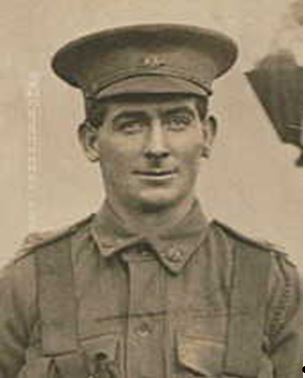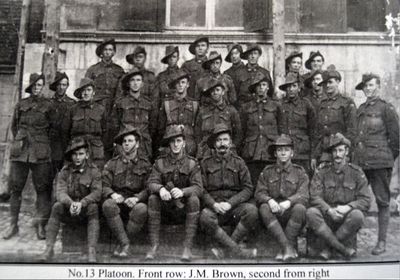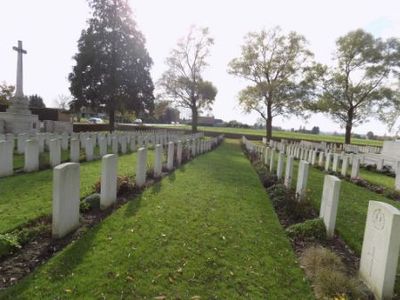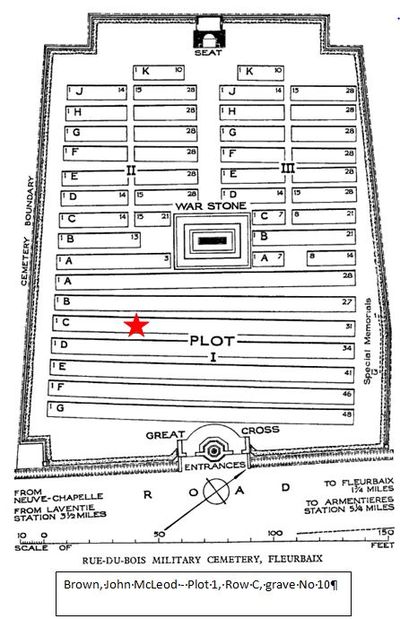Difference between revisions of "John McLeod Brown"
From Our Contribution
| (3 intermediate revisions by the same user not shown) | |||
| Line 57: | Line 57: | ||
| − | On 12 Jul 1915 John was admitted to hospital in Abbassia, before being released back to duty on 16 Jul 1915. On 3 Sep 1915 the battalion marched to Qubba Station and boarded a train for Alexandria where the [[HMT Ivernia]] awaited them. They sailed at 6:00pm for Mudross Harbour on Lemnos Island where they transshipped on 10 Sep 1916 to the much smaller [[ | + | On 12 Jul 1915 John was admitted to hospital in Abbassia, before being released back to duty on 16 Jul 1915. On 3 Sep 1915 the battalion marched to Qubba Station and boarded a train for Alexandria where the [[HMT Ivernia]] awaited them. They sailed at 6:00pm for Mudross Harbour on Lemnos Island where they transshipped on 10 Sep 1916 to the much smaller [[HMS Sarnia]] for the last part of the voyage to Anzac Cove. Disembarking at midnight in the dark they spent the rest of the night in Waterfall Gully. (Two platoons of 'A' Coy were used as working parties on the beach for the next two days. |
| − | By the time John reported sick on 3 Nov 1915 on Gallipoli sickness was putting more men out of action than the fight itself, 137 versus 36. John was again hospitalised, this time with the 7th | + | By the time John reported sick on 3 Nov 1915 on Gallipoli, sickness was putting more men out of action than the fight itself, 137 versus 36. John was again hospitalised, this time with the [[7th Field Ambulance]] with jaundice. Passed on to the 13th Casualty Clearing Station, he was evacuated to Alexandria aboard the [[HS Maheno]] before being admitted to the [[1st Australian Auxiliary Hospital]] on 15 Nov 1915 in Heliopolis. John was fit enough to return to duty on 8 Dec 1915 when he was sent to the Ghezirah Base. A third hospital visit occurred from 19 - 23 Mar 1916 when he was hospitalised with an eye problem. |
| − | On 2 Apr 1916 John was transferred to the [[51st Battalion]] in Serapeum, at that time being raised in Egypt for service on the Western Front. John suffered a short bout of Influenza while on the Canal Defence Line. On 4 Jun 1916 the battalion boarded trains at the Serapeum West siding for Gabbary Quay Alexandria where they boarded [[HMT Ivernia]]. Leaving harbour at 9:00am on 5 Jun 1916, they arrived in Marseilles at 7:00am on 11 Jun 1916. On 12 Jun 1916 they began their journey north in cattle trucks to Caestre where they detrained on 14 Jun 1916. | + | On 2 Apr 1916 John was transferred to the [[51st Battalion]] in Serapeum, at that time being raised in Egypt for service on the Western Front. John suffered a short bout of Influenza while on the Canal Defence Line without being hospitalized. On 4 Jun 1916 the battalion boarded trains at the Serapeum West siding for Gabbary Quay Alexandria where they boarded [[HMT Ivernia]]. Leaving harbour at 9:00am on 5 Jun 1916, they arrived in Marseilles at 7:00am on 11 Jun 1916. On 12 Jun 1916 they began their journey north in cattle trucks to Caestre where they detrained on 14 Jun 1916. |
Their relief of the 10th Battalion, then holding a section of the front line just south of Fleurbaix began on the evening of 22 Jun 1916, with one Company relieving a 10th Battalion company each alternate night. It was reported that no casualties occurred during the battalion change over, but that by 30 Jun 19016 the battalion had lost 5 men Killed in Action, one had Died of Wounds, and 17 had been Wounded. | Their relief of the 10th Battalion, then holding a section of the front line just south of Fleurbaix began on the evening of 22 Jun 1916, with one Company relieving a 10th Battalion company each alternate night. It was reported that no casualties occurred during the battalion change over, but that by 30 Jun 19016 the battalion had lost 5 men Killed in Action, one had Died of Wounds, and 17 had been Wounded. | ||
| Line 117: | Line 117: | ||
[[Category:Labourer]] | [[Category:Labourer]] | ||
[[Category:Presbyterian]] | [[Category:Presbyterian]] | ||
| − | |||
[[Category:1916 Deaths]] | [[Category:1916 Deaths]] | ||
[[Category:Accidental deaths]] | [[Category:Accidental deaths]] | ||
[[Category:Gosnells]] | [[Category:Gosnells]] | ||
Latest revision as of 18:37, 12 October 2023
 Photos courtesy of grand-niece Joy Moore | |
 | |
| Personal Information | |
|---|---|
| Date of Birth | 14 Nov 1890 |
| Place of Birth | Essendon. Victoria |
| Death | 27 Jun 1916 |
| Place of Death | Fleurbaix, France (Petillon Sector) |
| Age at Enlistment | 24 years, 4 months |
| Description |
5'6½" (1.69m) tall ; 145lbs 65.771 kg ; sallow complexion ; hazel eyes ; brown hair ; tattoo on left wrist |
| Occupation | labourer |
| Religion | Presbyterian |
| Address | Gosnells, Western Australia |
| Next of Kin | Brother , Mr Richard Cranfield Brown |
| Military Information | |
| Reg Number | 22 |
| Date of Enlistment | 15 Feb 1915 |
| Rank | Private |
| Unit/Formation | A Coy 28th Battalion, transferred to 51st Battalion |
| Date of Embarkation | 9 Jun 1915 ‒ 2 Jul 1915 |
| Ship Embarked On | HMAT A11 Ascanius |
| Fate | Accidental death - shot by sentry |
| Monument |
Gosnells War Memorial Gosnells Road Board Honour Roll Gosnells Ward Honour Roll Australian War Memorial |
| Medals |
1914-15 Star British War Medal Victory Medal |
Contents
Pre War
John McLeod Brown, born 14 November 1890, Essendon, Victoria, Australia his parents were Robert Brown and Catherine Rachel Brown (nee McLeod), 62 Moreland Street, Footscray, Victoria. Electoral Roll entry: 1912 The Park, Pinjarra, labourer
War Service
Entered Blackboy Hill camp on 13 Feb 1915 and was initially posted to 'C' Company of the 24th Battalion which at that time was being raised in Western Australia to supplement the main recruitment drive in Victoria. Later when Victorian enrolments managed to fill the 24th Battalion locally, he was allocated to 'A' Company of the 28th Battalion and he sailed with them to Egypt aboard HMAT A11 Ascanius.
On 12 Jul 1915 John was admitted to hospital in Abbassia, before being released back to duty on 16 Jul 1915. On 3 Sep 1915 the battalion marched to Qubba Station and boarded a train for Alexandria where the HMT Ivernia awaited them. They sailed at 6:00pm for Mudross Harbour on Lemnos Island where they transshipped on 10 Sep 1916 to the much smaller HMS Sarnia for the last part of the voyage to Anzac Cove. Disembarking at midnight in the dark they spent the rest of the night in Waterfall Gully. (Two platoons of 'A' Coy were used as working parties on the beach for the next two days.
By the time John reported sick on 3 Nov 1915 on Gallipoli, sickness was putting more men out of action than the fight itself, 137 versus 36. John was again hospitalised, this time with the 7th Field Ambulance with jaundice. Passed on to the 13th Casualty Clearing Station, he was evacuated to Alexandria aboard the HS Maheno before being admitted to the 1st Australian Auxiliary Hospital on 15 Nov 1915 in Heliopolis. John was fit enough to return to duty on 8 Dec 1915 when he was sent to the Ghezirah Base. A third hospital visit occurred from 19 - 23 Mar 1916 when he was hospitalised with an eye problem.
On 2 Apr 1916 John was transferred to the 51st Battalion in Serapeum, at that time being raised in Egypt for service on the Western Front. John suffered a short bout of Influenza while on the Canal Defence Line without being hospitalized. On 4 Jun 1916 the battalion boarded trains at the Serapeum West siding for Gabbary Quay Alexandria where they boarded HMT Ivernia. Leaving harbour at 9:00am on 5 Jun 1916, they arrived in Marseilles at 7:00am on 11 Jun 1916. On 12 Jun 1916 they began their journey north in cattle trucks to Caestre where they detrained on 14 Jun 1916.
Their relief of the 10th Battalion, then holding a section of the front line just south of Fleurbaix began on the evening of 22 Jun 1916, with one Company relieving a 10th Battalion company each alternate night. It was reported that no casualties occurred during the battalion change over, but that by 30 Jun 19016 the battalion had lost 5 men Killed in Action, one had Died of Wounds, and 17 had been Wounded.
John's records contain an entry "Accidentally killed by Sentry in the Field - 27 Jun 1916."
A.C. 1799 proceedings of Court of Enquiry assembled at Front Line France on 27/6/16 by order of Lt. Colonel A.M.Ross DSC, OC 51st Battalion A.I.F. for the purpose of enquiring into the accidental shooting of No. 22 Private Brown, J. McL., a soldier of "C" Company 51st Battalion A.I.F. President Capt. M.C. Kelly, Members Lt. H.D. Williams & Lt. F.W. Bailey.
1st witness Lieut. A. L. Miller, “C” Coy 51 Battalion, Acting Officer in Charge “C” Coy, been sworn states:-
At about 2.45 a.m. this morning I heard a shot fired followed by groaning. On going to No. 3 Sally Post Cpl. Weaver, who was in charge of the post informed me that one of the Listening Post had been shot when returned. I went just outside the Sally Post and found Private Brown lying wounded. I questioned the sentry No. 3814 Pte. Constance, J. He told me that he had fired the shot. I asked him had he challenged before firing, and he said “Yes” “I challenged twice’. I immediately sent for stretcher bearers who rendered first aid. I also telephoned for the Medical Officer’s arrival. At 3.10 a.m. the Medical Officer saw the deceased and pronounced life extinct. I immediately placed Pte Constance under arrest, pending enquiry.
2nd witness No. 3814, Pte. Constance , J. “C” Coy, 51 Battalion, AIF, being sworn states:-
Between2 and 3 a.m. this morning a party approached the Sally Post, where I was on sentry duty. I challenged the party and the leading man replied “Friend” in a low voice. On challenging a second time I received no reply. The party started to approach slowly in a crouching attitude. I then fired on the leading man who was almost inside the Sally Post. The man I fired at was Pte. Brown, J. M.
3rd witness No. 1191, Corpl. Weaver, R., “C” Coy 51 Battalion, AIF, being sworn states:-
I was in charge of No. 5 Bay this morning. I posted Pte. Constance as sentry on the Sally Post at about 2 am At about 2.45 a.m. I heard the sentry challenge some person twice in a clear voice. The sentry then fired. I heard no reply to either challenge.
4th witness No. 3119, Pte Slipper, H. E., “C” Coy, 51 Battalion, being sworn states:-
On returning to the trench from the listening Post at about 2.30 a.m. this morning a flare was sent up from about a few feet from the Sally Post. The party immediately crouched down, Pte. Brown being the leading man, followed by myself. After the flare was extinguished we began to make our way slowly to the entrance of the Sally Post, when we heard a challenge. At the time Pte. Brown was going down an incline, and could not stop immediately. The sentry then challenged a second time, and we halted. I heard Brown mutter something, and a shot was fired immediately hitting Pte. Brown.
Question by President. Did Pte Brown reply to the first challenge by the sentry? Answer. I did not hear him.
5th witness No. 2787 L/Cpl. McDonald, W. J., “C” Coy., 51 Battalion, being sworn states:-
This morning I was in charge of No. 5 Listening Post. At about 2.35 a.m. the party commenced to come back into the trench Pte. Brown leading, myself in the rear of the party. When Brown was about 7 yards from the entrance to the Sally Post a flare went up. I gave the order for the party to crouch down which they did. On the flare going out we again moved forward. At the time Pte. Brown was going down an incline. I heard the sentry call “halt”, but heard no reply to the challenge. A couple of paces further on the sentry again challenged in a louder voice I again heard no reply. After a short pause the sentry fired.
Finding of the Court. The Court having carefully considered the evidence put before them are of the opinion that:- Private Brown met his death by being shot by a sentry (Pte Constance) whilst in the execution of his duty. No blame being attached to anyone."
John's file contains the evidence given it appears that he was part of a Listening Post in front of the lines and although challenged twice failed to respond and was shot by a sentry. Wounded at about 2.45am he was taken into the trench, and although treated by stretcher bearers he died at 3:10am.
Notes
Two of John's brothers enlisted in Victoria, 751 Pte Richard Cranfield Brown served with the 24th Battalion, and 597/4447 Sapper Robert Leslie Brown with the 8th Field Company Engineers. both returned to Australia in 1919.
For more information about the history and heritage of the City of Gosnells, please contact the Heritage Coordinator on 9391 6011

